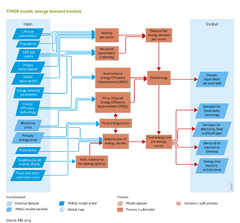Energy demand/Description: Difference between revisions
Jump to navigation
Jump to search
Oostenrijr (talk | contribs) No edit summary |
Oostenrijr (talk | contribs) No edit summary |
||
| Line 39: | Line 39: | ||
IMS is the indicated market share of different energy carriers or technologies and c is their costs. In this equation, λ is the so-called logit parameter, determining the sensitivity of markets to price differences. | IMS is the indicated market share of different energy carriers or technologies and c is their costs. In this equation, λ is the so-called logit parameter, determining the sensitivity of markets to price differences. | ||
The equation takes account of direct production costs and also energy and carbon taxes and premium values. The last two reflect non-price factors determining market shares, such as preferences, environmental policies, infrastructure (or the lack of infrastructure) and strategic considerations. The premium values are determined in the model calibration process in order to correctly simulate historical market shares on the basis of simulated price information. The same parameters are used in scenarios to simulate the assumption on societal preferences for clean and/or convenient fuels. However, the market shares of traditional biomass and secondary heat are determined by exogenous scenario parameters (except for the residential sector discussed below). Non-energy use of energy carriers is modelled on the basis of exogenously assumed intensity of representative non-energy uses (chemicals) and on a price-driven competition between the various energy carriers ([[Daioglou et al., | The equation takes account of direct production costs and also energy and carbon taxes and premium values. The last two reflect non-price factors determining market shares, such as preferences, environmental policies, infrastructure (or the lack of infrastructure) and strategic considerations. The premium values are determined in the model calibration process in order to correctly simulate historical market shares on the basis of simulated price information. The same parameters are used in scenarios to simulate the assumption on societal preferences for clean and/or convenient fuels. However, the market shares of traditional biomass and secondary heat are determined by exogenous scenario parameters (except for the residential sector discussed below). Non-energy use of energy carriers is modelled on the basis of exogenously assumed intensity of representative non-energy uses (chemicals) and on a price-driven competition between the various energy carriers ([[Daioglou et al., 2014]]). | ||
===Heavy industry=== | ===Heavy industry=== | ||
Revision as of 15:58, 10 August 2015
Parts of Energy demand/Description
| Component is implemented in: |
|
| Related IMAGE components |
| Projects/Applications |
| Key publications |
| References |
